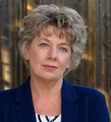J.C. Paulson's Blog, page 2
February 15, 2022
Blood and Dust. Chapter One.
My first historical fiction book, a western based in 1880s Canada, is out this week! Here's a peek at a bit of chapter one.
Chapter One
June, 1882

By now, Alexander, whoever the hell he was, lay there twitching in complete shock. What do you do for shock? Newspapers and book learning weren’t helping me with that issue.
“Don’t you fucking die on me now,” I told him, leaning up to speak right in his ear. “Not after all this. Don’t you dare fucking die. I’ll make you a nice leg, if you just won’t die.”
He didn’t say anything, of course.
“Are you done, James?”
“Oh, sorry, yes. You can let go now, Bert. Be careful as you step away. The floor’s slippery.”
“Someone’s coming,” he said.
I couldn’t hear anything, but I knew better than to question him. I saw, he listened.
Sure enough. Ten seconds later, the door flew open.
Standing there were two blazing eyes, blue as the summer sky, snapping with fury and fear. And a wobbling gun, trained right directly on my torso.
The sun glowed behind this apparition, and let’s face it, I wasn’t exactly expecting someone to walk right in just then. The firearm had my full attention.
Therefore, it took a few seconds before I could appreciate that the eyes and gun belonged to a woman. The rest of her, shaking with emotion, was dressed in a sprigged calico gown, thin as gossamer and the palest lavender from too much laundering. I noticed this, even in my confusion, because the body underneath was slim and round and soft and quivering.
She spoke first.
“If he dies,” she said, “you die.”
Copyright J.C. Paulson 2020
Mario Dell'Olio: Man of music and letters

Dr. Mario Dell’Olio’s life is a richly steeped in letters and notes. The author of several books, both self-published and traditionally-published, is also chair of the music department and ethics teacher at an independent school for girls in Manhattan, where he conducts the concert and chamber choirs.
Yet there is a third part to his harmony. Along with his Master of Music in Vocal Performance, he holds a Doctor of Sacred Music and a Master of Religious Education, and was a seminarian at the Pontifical Gregorian University, Rome, Italy. His thoughts on religion, spirituality and their place in our lives are deeply considered and inform much of his work, as do his vast experiences. To read a work by Mario Dell’Olio is to understand ourselves perhaps a bit, perhaps considerably better than we had before cracking the spine. His newest work, Letters from Italy, arrives this week, and opens our conversation.
Welcome, Mario. Your new book, a creative nonfiction biography, launches today. How exciting! Please tell us about Letters from Italy and why you decided to write it.

My mother and father were always storytellers. Immigrants from southern Italy, they lived through the Fascist regime of Benito Mussolini and World War II. Tales of their childhood in a little town on the Puglian coast begat images of a fishing village, families from different socio-economic classes, and love born out of chance.
Their romance began in 1950 when my uncle sent a photograph of his new fiancée to his brother in New York City. Orazio, my father, who was living in a one-bedroom apartment in Little Italy, spotted an attractive young woman in the photo. What ensued was two years of correspondence that eventually led to their first encounter in the town of Bisceglie, Bari.
In a very real way, their letters were a precursor to match.com of the 21st century. Married nearly sixty years at the time of my father’s death, theirs was a love story like no other I have known.
While many stories of Italian immigrants cover the third wave of immigration to the United States, this describes the postwar years through to present day. It describes a family desperate to assimilate into American society while maintaining their strong cultural heritage. Navigating the tumultuous 1960s to the new millennium, Orazio and Nicoletta did just that.
Shortly after his death, Nicoletta found letters she wrote to him so many decades before. Although she had saved many of his letters, she had no idea that he had done the same. Many years later, I asked my mother to read them to me. Sitting at the kitchen table, she began the journey back through time, accessing memories long forgotten.
As she read each letter to me, her tangential stories became the foundation of Letters from Italy. Her detailed descriptions of the dresses she wore and the family conflicts that arose placed me into scenes I had only imagined in movies. I could picture every corner of her little house, every street of her ancient city, and came to know my deceased grandparents for the first time. Orphaned at twelve years of age, the images that came alive through her oral history prompted me to write their story. In many ways, I believe I had no choice. I had to write their story.
For three years, I transcribed conversations about my parents’ clandestine romance, about life during the war, and starting anew in New York City. Delving into history books to place their journey in a timeline, I gained perspective as I contextualized each vignette. I learned how one tended a vineyard at the start of the twentieth century, what it was like for ordinary citizens under the regime of Mussolini, and about the post-war experience of immigrants in New York.
Framed by the letters my parents wrote to each other during 1950–1952, the oral history that I’ve heard since my childhood will become a story of enduring love. I describe the hardship of my grandparents during the third wave of immigration to the United States, post-war Italy, and the tumult of the 1960s. My hope is that the reader will come to know an idealistic young couple who fell in love, embarked on a bold journey, and grew old together.
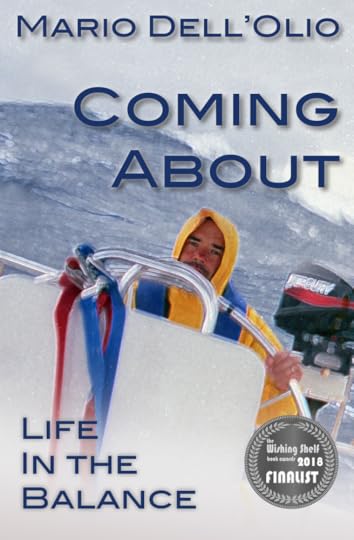
You often write from personal experience. Some books are memoirs, and others are fictionalized. What drives you to write in this way?
My stories feature characters searching for deeper meaning in their life experiences. My life’s journey has been imbued with the lessons I’ve learned through overcoming challenges. I have always been an avid journaler, so reflecting on my life and experiences is natural. I then look outward to the world around me, trying to find deeper meaning in the actions of others. I wonder what motivates people to act as they do. What makes someone kind or another person rude? How did they become that way? I develop characters as I journey through life. So many seem to be composites of people I've met. In my opinion, the path to self-discovery yields the most exciting stories because we've all been there. But the way each of us gets there is as unique as every grain of sand.
Some of your books are self-published and some are traditionally published. Is it difficult to manage a hybrid authorial life? What are the benefits of each?
This is a difficult question to answer. I learned a great deal about what it takes to be an author while writing my two self-published books.
After sending out several query letters, I decided to get my voice out there. I had stories to tell, and I wanted people to read them. As an unknown or new author, it's difficult to break into the traditionally published world. The decision to self-publish was easy. I wanted to write, and self-publishing allowed me to get my stories out there immediately. The difficulty was getting my work noticed. Marketing remains the most significant challenge for me as a writer.
I was thrilled that independent publishing companies published New Men and Letters from Italy. Whether it is correct, it provided the external validation that I sought. Traditional publishing also opened the door to editorial reviews, which are nearly impossible to get on self-published books. It also freed me from the hours spent designing covers and formatting the text. However, smaller publishing houses rely a great deal on the author to market along with them.
Tell us a bit about Coming About. It’s a harrowing tale.
Coming About tells the tale of one of the most traumatic experiences in my life. Not one but two sailing expeditions tested my mettle and pushed me to my physical and emotional limits. Sailing to a Caribbean island seemed to be a dream come true. But it quickly turned into a nightmare. My husband and I nearly lost our lives on both journeys. During the years following our rescue, I was asked to tell the story over and over again. All the while, I wracked my brain as I desperately searched for a deeper meaning to our struggle. Coming About tells of our struggles as our lives hung in the balance and the profound change in my perspective on life.
And your other books?
Body and Soul and New Men are coming-of-age stories. The characters struggle with identity, first love, and sexuality. Ethical dilemmas are ubiquitous and happy endings are elusive. The battles abound between self-knowledge and faith in an institution that condemns them for being gay. New Men and Forbidden Rome is fiction based on actual events in a Roman seminary during the 1980s. In addition, there is a short story, Cappuccino, that develops those plots.
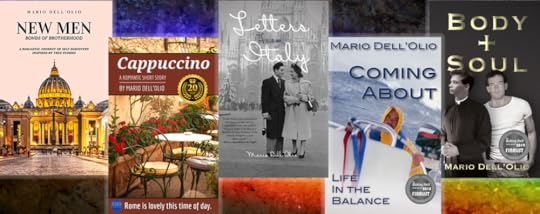
What are you working on now?
I am querying my fifth novel. Spanning four decades, Tilting Toward the Sun begins with the excitement and excess of the 1980s. A handsome sailor sweeps the main character off his feet. The enthusiasm of young love rocks his world. But when the ban on gays in the military rears its head, the officer must keep his secret or risk a dishonorable discharge. Following divergent paths, these young lovers face the tumultuous 1980s and 90s. Amidst the AIDS crisis, they navigate a world of fear and uncertainty as they seek not only to survive but to thrive. Tilting Toward the Sun is a journey of undying devotion and love through the decades. As youth turns to maturity, they grapple with life’s challenges reaching for the elusive happily ever after.
And now, I'm trying to come up with ideas for my next novel!
How do you balance your busy life as a choir conductor and teacher with writing?
I have a very full teaching load with four sections of ethics and two choirs. So I do most of my writing during my summer break. I can usually write my first and second drafts in July and August. The rest of the editing lasts through the academic year. Weekends are the only times I get to write.
Where can we find your work, and where can we find you on social media?
Thank you so much, Mario. All the best.
February 11, 2022
Author Marian L. Thorpe creates an "empire on the edge of history"
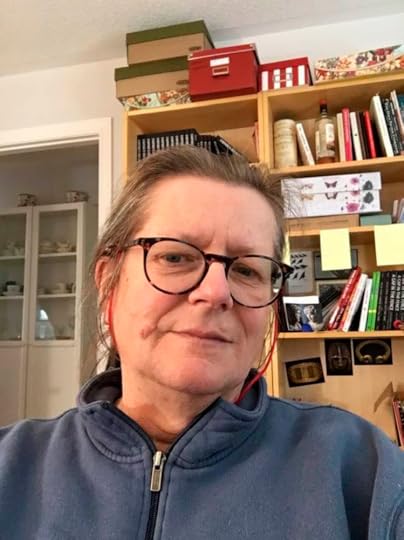
Essays, poetry, short stories, peer-reviewed scientific papers, curriculum documents, technical guides, grant applications, press releases – if it has words, it’s likely Marian L Thorpe has written it, somewhere along the line. But nothing has given her more satisfaction than her novels. Combining her love of landscape and history, set in a world reminiscent of Europe after the decline of Rome, her books arise from a lifetime of reading and walking and wondering ‘what if?’
Pre-pandemic, Marian divided her time between Canada and the UK, and hopes she may again, but until then, she resides in a small, very bookish, city in Canada, with her husband Brian and Pye-Cat.
Welcome, Marian. You are an author of historical fiction. Please tell us why you chose that genre . . . or did it choose you?
I think it chose me. It’s interesting that my three ‘apprentice novels’ – the ones that will never see the light of day – were all contemporary, but the books I truly loved (and love) are almost all historical in some aspect. When I started writing Empire’s Daughter, I was, in my mind, writing fantasy, but one whose world I built around what I knew, which was the early-medieval history of Britain. But I wasn’t terribly interested in dynasties and wars, although both are important in the series. My father, who was an amateur historian of the Plantagenet and Tudor periods, had taught me the importance of social history, how the major events of any time has unintended and lasting influences on everyday life and the people of towns and villages and farms. So that’s what I wanted to address.

Tell us about the books themselves. I believe you have five novels and a novella in the Empire’s Legacy series? Where did the inspiration come from?
There are two converging inspirations for the series. One was the experience of my mother and other women of my family in Britain and Denmark during WWII. Britain conscripted women from 1941 onwards into non-combatant roles – although both my mother and aunt volunteered, serving in the Signals Corp as teletype operators. My father’s first cousin had married a Dane, and was part of the Danish resistance. So I took that basic concept of women’s conscription, of being asked to help defend your country because the men couldn’t do it all – and changed it a little, into a combatant role – but my real interest was how it changed the traditional lives of women.
The second inspiration was simply my love of the British landscape, the way layers of history survive side by side (or on top of each other); how the Roman occupation is still tangible through the routes of major roads, through Hadrian’s Wall and the remnants of forts; through the Vindolanda and Bloomberg tablets and letters, which give us a glimpse into the humanity behind the history. And of the people who were there before the Romans came, and were there – but changed; they must have been – when the Romans left.
How much research did the stories require, and how was that done?
By the time I started Empire’s Daughter – I was about 40 – I’d been reading early-medieval British history for over twenty years. It started with a fascination with Arthurian legend but quickly expanded and spread from that: I wanted to know the real history, although the stories still resonate (and in Empire’s Reckoning, I have used at least three aspects of the legends, although turned on their heads a bit.)
One of the Christmas presents my now-husband gave me early in our relationship were copies of The Anglo-Saxon Chronicles and The Domesday Book. So, Daughter needed almost no research: it was all in my head, except the sword lessons. For those I did research!
The real research began with the second book, although I had a pretty good background to build on through courses in Scottish history I’d taken in university. We went to Hadrian’s Wall in March so I would know what it felt like in the winter. After that I took several university courses on Roman and early-medieval European history. I have a stack of history books that would kill me if it fell over.
In 2020, just before the world realized the seriousness of the pandemic, I went to Rome for a whirlwind research trip. I continue to research: each book brings forth new aspects of my characters and my world, for which I need to have a solid basis; so right now I’m reading about powerful Roman and Byzantine women for one character, and the life of Roman soldiers for another.

You are often congratulated for your detailed and perhaps exquisite world-building. Do you agree with that assessment from reviewers? How do you weave the words without attacking your readers with information dumps?
I think I have to acknowledge this is a strength, simply because so many people have commented on it. Because I write first-person, and both my memories and my imagination are very sensory-based, I write what my character is not just seeing, but hearing, feeling, tasting, smelling. And with first-person, the reader can only know what the character knows. In the first half of Empire’s Daughter, where Lena is in a familiar environment, if a brand-new situation, the new characters allow her to consider her familiar environment through their eyes, and explain, but only as the situations arise. After that, everything’s new for her, too — and so we learn about the world alongside her.
The “world” does not exist. While it is a very human plane, it is your creation. Why did you decide to approach your novels in this way?
Well, for two reasons. One is a bit tongue-in-cheek: I’m simply not disciplined enough to be bound by real history – I’d get annoyed by the restrictions of sticking to timelines and facts. The other, more serious answer, is tied into the answer to question 8. I had concepts I wanted to challenge and ideas I wanted to put forward, ones that would and do make some readers uncomfortable. Doing it within a speculative fiction setting can be less threatening, because the reader can distance themselves somewhat – and yet consider how these ideas relate to our own world. I know how important speculative fiction was in shaping my own views on many things, and I’ve had readers tell me that my books have led them to reconsider their own ideas and assumptions.
Your characters are also very clear, very distinct from each other. From a craft perspective, how do you create them?
I wish I could tell you. My characters simply appear in my head, almost fully formed. Their backstories usually emerge somewhere in the novels – at least for the main and major supporting characters – but it feels more like discovering things about a friend you know rather than inventing. Voice is the hardest thing – Lena (the narrator of Books 1 – 3) is not the narrator of later books, and finding the first person voice of the new narrators, all of whom have been supporting characters earlier – can be a challenge. I know how they speak, what makes their voices stand out; how they think, their internal voice, is another matter.
Are there certain messages or morals you hope to express, and if so, why?
The overarching message is spoken by the character Casyn in Empire’s Daughter: “We cannot shape the circumstances to fit our lives, only our lives to fit the circumstances. What defines us, as men and women, is how we respond to those circumstances.” This goes back to my interest in social history and social change, but taken to the level of the individual.
The other message, which may become clearer over the course of the series, concerns attitudes towards people who would in our world and time be described as LGBTQ+. I didn’t want to write “representation;” I wanted to write a world where how sexuality is expressed is simply part of who a person is.
But as the series progresses, we see that not every land in my world has this freedom, and attitudes towards both same-sex relationships and women as equals will challenge my protagonist’s world view. Lena’s journey (literal and figurative) into new lands and ways of thought, and her creation of a “found family” that challenges convention, parallels her involvement in conceiving a political structure that is equally unconventional. Here I’m looking at social history and structures at the individual level, but extending outward to the possibilities for new sorts of state and political alliances – without suggesting a Utopia is possible.
Are there more books to come in the Empire’s Legacy series? What are you working on now?
Two more – or at least that’s the plan. Currently I’m working on Empress & Soldier, which is a second entry point into the series. It’s narrated by two characters who appear towards the end of Empire’s Exile and remain important in the subsequent books: the soldier Druisius and the Empress Eudekia. It will intersect with that last section of Exile, but from their viewpoints.
After that, Empire’s Passing (working title) is the last book in this series: without giving too much away, the narrators will be Lena again, now in her 50s, and her son Colm – and its ending takes the series full circle.
Please tell us how we can find your books, as well as yourself on social media.
My social media links:
https://linktr.ee/marianlthorpe
Books:
Empire’s Legacy (box set of first three books): https://rxe.me/54VVP1
Oraiáphon: https://rxe.me/WLVKRF
Empire’s Reckoning: https://rxe.me/SFY7WB
Empire’s Heir: https://rxe.me/MY4LRC
Thank you so much, Marian. What a pleasure it has been to learn more about your work.
January 23, 2022
Author Steve O'Farrell creates a young sleuth for the ages
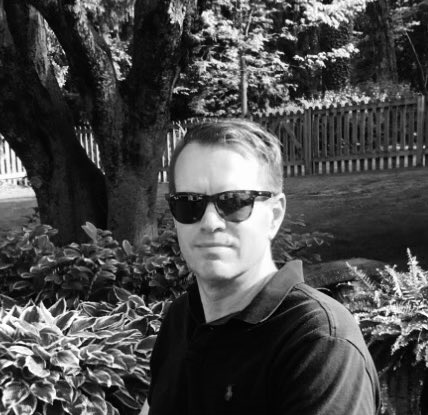
As a youngster, I read Nancy Drew, Trixie Belden, The Bobbsey Twins and myriad other middle-grade mystery novels as if gobbling chocolate.
When I virtually met Steve O’Farrell and became aware of his first novel, Simone LaFray and The Chocolatiers’ Ball, it immediately hit my reading list. I was not alone.
Simone has quickly become a sweet commodity. The story of a young spy growing up in her family’s Parisian patisserie is sugared with wonderful and often quirky characters, delicious treats and a delightful plot perfect for all ages.
O’Farrell first wrote Simone as a short story, but it turned into an award-winning novel. Simone has won a Moonbeam Award, New York City Big Book Award, Queer Indie Award, LitPick Award, (sm)art festivals award and was a finalist for Book Pipeline and National Indie Excellence Award.
Now, fans are highly anticipating book two: Simone LaFray and the Red Wolves of London releases in 2022.
Please meet Steve O’Farrell.
Outside of writing, can you boil your life down into two sentences?
Lifelong Marylander, married with two sons. I run a real estate appraisal and consulting business, am involved in several community organizations, and I don’t do well with idle time.
Not being a full-time writer, what compelled you to write your first novel? And what inspired Simone LaFray?
As part of my job, I write four to six hours a day, just not fiction. Over the years I developed a pretty tight writing style and always felt that a novel was in me somewhere. After reading a ton of early chapter and middle-grade books with my boys, I did try to form a few story outlines, but nothing stuck.
The inspiration for Simone LaFray came out of nowhere. We were on a big family vacation and for whatever reason, there were a lot of kids in the house. They were always spying on each other and playing a lot of hide-and-seek. One evening over dinner, my niece asked me to give her a spy name and I blurted out Simone LaFray five seconds later. She was into anything Parisian that summer, so it just fit. I couldn't shake it and about two weeks later I wrote the short story in one night. It has been quite a ride since.
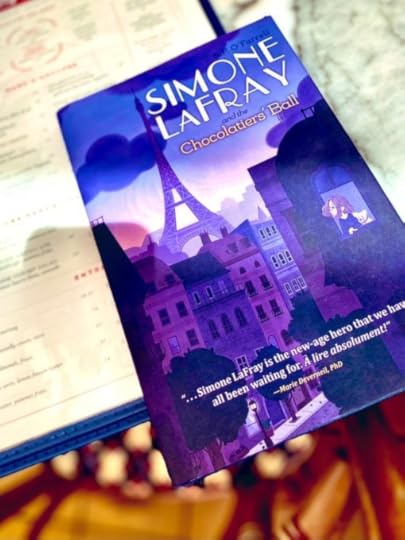
What is the vision for the Simone LaFray mystery series?
The entire series will span six or seven books and there is a definite end. The first story was actually in an early chapter form, but after a lot of feedback, I decided that an expansion would be better suited in the middle grade genre. The initial plotting was enormous in scope and I soon realized that I actually had a series as opposed to a single novel. Simone LaFray and the Red Wolves of London (Book #2) will release in the spring of 2022 and I hope to release subsequent titles every eighteen months or so.
The first book has garnered considerable interest and is now being represented for a possible motion picture. Who knows where this is all going, but I’m enjoying the ride.
Second installments in a series are notoriously difficult to write. What specific challenges did you have?
Great question. After finishing the first book, I spent six months writing a second book by the seat of my pants with no real outline. It was a complete disaster and I ended up scrapping all of it. Just before deleting the file, the weight of a second installment sunk in. Second installments need to expand the protagonist’s world, build the stakes for the over-arching conflict, and leave the reader wanting more. The trick is allowing the hero to cross the goal line, but not necessarily spike the ball. It is a delicate balance.
All writers talk about process. How would you describe yours?
As I wasted six months trying to be a pantster, I’m clearly not that. Closer to a plotster, but not in a traditional manner. With each book, I have a clear idea of how they start and end. I then form three or four high notes that I want the impending story to contain. These can be actions, character epiphanies, or even changes in setting. The real chore is connecting all of these into a coherent, compelling plot and laces the start to the finish.
Where are your books available and how do people follow you?
The books are available just about everywhere in both print and e-form. We are considering Audible versions, which should be available later in 2022. The international distribution has been quite successful with the first book reaching No. 1 statuses around the globe. You can follow me on Instagram, Twitter, TikTok, Facebook, and Goodreads.
https://twitter.com/SPOFarrell3
https://vm.tiktok.com/TTPdMvhfsF/
https://www.instagram.com/s.p.ofarrellofficial/
https://www.facebook.com/SimoneLaFray
www.brandylanepublishers.com (Publisher website)
October 23, 2021
Go for trad media coverage like a pro

Image credit: Roman Kraft, unsplash
I likely don’t have to tell you that the world of traditional media has moved to an entirely new planet in the last perhaps 15-20 years. There have been significant challenges for a while, which hit hard during the 2007-2008 recession on the heels of the increasingly complex media environment caused by the Internet.
Its ostensibly “free” nature is the primary cause of the serious problems faced by traditional media. Facebook, Google and the other media giants have changed the landscape and not for the better; recently, this has become even more dreadful. Preaching to the converted or the perverted, depending, does not assist us in advancing democracy. Nor, necessarily, does it help us get our messages out there.
But that’s a different column.
Layoffs, slashed budgets, and reorganization have affected local newspapers, television and radio stations. Many newspapers have closed their doors. This does not horrify other people the way it horrifies me, but I still ask people to try to imagine a community without a daily newspaper or a local TV station. How does a community function without methods of disseminating information? I would argue that local media still have an extremely important role to play, both in reporting and in commentary.
One of those roles is telling your stories.
The downside of the recent media mess is that your message must be loud, clear, and compelling like never before. Even in the last few months I spent at the local paper years ago, the city editor and I made increasingly difficult decisions on what to cover and what not to cover. In the ensuing years, these decisions have become even harder.
Fewer reporters, travel restrictions, a smaller news hole – they all contribute to a crisis in coverage. People increasingly get their information from the Internet, but even the big boys steal trad media information, repackage it and load it up as original work. Without the main information coming from news gathering organizations, you have very little in terms of reliable news or commentary.
As for everyone, most authors have limited hope in getting their book news out there unless they begin with their local media. So, consider some of these basics and go in there like a pro.
1. Be sure you are available for interviews. I can’t tell you how often I received press releases only to find it impossible to reach someone in a reasonable length of time. Everyone is busy, but if you return a 9 a.m. phone call at 4 p.m., there is obviously less time to prepare a story for deadline. The writer is probably trying to do three things, and it’s important he/she/they can count on your call-back at a reasonable time.
2. Make sure your press release has a hook. “I just published a book!” is not a hook — unless, perhaps, you are already famous in some way. Instead, consider: Why is your book relevant? Can you offer a genuine and interesting back story? Is the content meaningful to an ongoing community news story? Do you have a special voice? Can your community benefit from reading your book? Think hard about why your book deserves to be in the news. Be sure to send your release well ahead of an event and follow up with a second send and a phone call. KEEP A MEDIA LIST HANDY! And just like your very first paragraph in your first chapter, make your first para in your release compelling.
3. Press releases are shockingly incomplete and inaccurate. I received one from a federal minister’s office for a press conference that was booked for 11 p.m. Yup. An hour before midnight and well past presstime. This is GOVERNMENT for heaven’s sake. Obviously, the minister’s office meant 11 a.m., but one still must confirm such things. It took a couple of extra phone calls and an hour’s wait on a busy day to check something that should have been a no-brainer. CHECK YOUR BOOK READING OR LAUNCH DATE AND TIME 80 TIMES.
4. Your press release should be no longer than one page. If you have more to say, add a “backgrounder” page and DO NOT FORGET TO SEND A COPY OF THE COVER and YOUR PHOTO.
5. Remember to avoid jargon and short-cuts, and for the love of God, do not EVER stretch the truth. Do not say you’re a bestseller if you can’t substantiate it. Be clear and write simply.
6. Going “off the record” is not a decision you can make alone. It’s unlikely to affect an author, but still, it could. Loose lips do sink ships; what if you inadvertently diss another book? There is a strict rule about this: you must get the reporter's verbal consent BEFORE going off the record. One of the biggest mistakes people make is telling a reporter a bunch of information, or expressing opinions, and then saying, “by the way, oops, that was all off the record.” Nope.
7. There is no point in asking if you can see the story before it is published. Respectable media outlets have strict policies about this.
Good luck, all you lovely authors.
September 20, 2021
Why I leave the bedroom door open

I had a small sexual revelation at a recent book club meeting.
The host, a friend of long standing, had persuaded her fellow readers to take on my series and invited me to be present for their discussion.
The questions were fantastic, and I both appreciated and enjoyed the interaction. But what stopped me in mid-babble, near the end of the event, was the sudden comment, “These are the hottest books I’ve read in a long time.”
Hot, as in steamy. Sexy. Erotic.
Dumbfounded., my brow creased as I turned to this lovely woman. “Really?”
Another attendee piped up to say she read some of the warmer bits to her husband, who later recited them back to her. My mouth by this time had formed an (unattractive) O. Commenter No. 3 said, “In other words, they got laid,” to gales of laughter and pinkening cheeks.
I looked from one woman to the other and said, “Do none of you read romance?” All I got in return were shrugs. And every single one of them – nine out of nine – gave me a thumbs up on the steam.
Two days later, another reader (and author) caught up to me at a literary festival bearing my latest book. “Your sex scenes are so good,” she said, rather out of the blue.
“There aren’t many in this book,” I pointed out.
“No,” she said, sadly. “I admit I was a bit disappointed.”
I do not write this in self-congratulation. Well, not entirely. Rather, I was completely amazed by the positive comments about the intimate scenes between my two main characters, Adam Davis and Grace Rampling.
This was, in part, because some reviews of my books contain explicitly negative comments. And I’ve frequently been questioned about them; why did I include them at all? These are supposed to be mystery novels.
They are. However, they are mystery-and-love novels (NOT romantic suspense, in my opinion), and I can’t apologize. The brain will do what it does.
When Adam first occurred to me as a fully-formed, beautiful but somewhat damaged human, I instantly envisioned him finding a lover. I didn’t invent Adam. I woke up one night and he was just there, lost, alone, recovering from heavy drinking and suffering from PTSD. Part of him was me.
Grace, with her own history and confusion about men, emerged next — ethical, dedicated, passionate, goofy and decidedly sexual. There she was, too, flaming red hair and chocolate eyes, right in front of me.
They were to become my crime-solving team, but almost as importantly, they were also to become a sexual, passionate couple who bring healing and joy to one another.
SPOILER ALERT:
Yes, there are plot purposes to the intimacy. When they finally come together, Adam experiences one of his PTSD episodes. Grace’s physical love brings him back to the present, to the reality of being near another beautiful human, naked and vulnerable and caring. And so the healing begins.
Sex is part of life, for most (with apologies to those who self-identify as asexual). It’s good, it’s bad, it creates unbearable longings, it fills us and destroys us, and it sometimes puts us back together again. Sex advances or stops relationships. It helps us form deep understandings and connections, and unfortunately, aversions. When we are lucky, sex expresses and strengthens love.
And sometimes, sex is just sex, although I personally do not recall such an experience.
Therefore, I will not slam the bedroom door.
Whether I have, as an author, been successful in describing this erotic and loving relationship is one thing and up to you, gentle reader, to decide. Whether stories about life should include the full range of emotional experience is, to me, not a question at all.
As Hannah Tennant-Moore said in her great blog about sex and the novel, “. . . often the best writing about sex can be found in books that are not about sex at all. Rather, many great novels portray sexual encounters as an inseparable part of the extraordinary ordinariness of daily life.” (You can find it here https://lithub.com/the-best-literary-writing-about-sex/).
I do not claim my mysteries are “great novels” (although I hope they are fun to read and deal with important topics.) I will claim that sexual encounters are inseparable from daily life, including Adam and Grace’s.
Fair warning.
*image by Zelle Duda, unsplash
July 15, 2021
K.T. McGivens and her empowering female sleuth

Florida author K.T. McGivens tucks her real identity behind a pen name, but in this interview tells us all we really need to know. Inspired long ago by Nancy Drew, she has created a female sleuth who investigates crimes post-World War II; yet Katie Porter is very much a woman for the modern age.
Welcome, KT. You are the author of the Katie Porter mystery series. Can you tell us what inspired the series and how many books you have published?
There were several factors that inspired me but the main reason was that I wanted to do something that might empower women, especially young women. I am so tired of reading stories and watching TV programs that victimize us. Nearly everything we see nowadays have women being kidnapped, raped, tortured, killed . . . really? Enough already!
As a youngster I discovered the joy of reading through the Nancy Drew books. A few years ago, strictly by accident, I ran across a couple of volumes, re-read them and realized how wonderful they are. I began collecting them and own several very old editions and saw the benefits of loosely modeling my own mystery series after them.
So far, I have published 11 books. One is an anthology of my poetry and there are currently 10 books in the Katie Porter Mystery series. I am currently working on book 11 in the series.
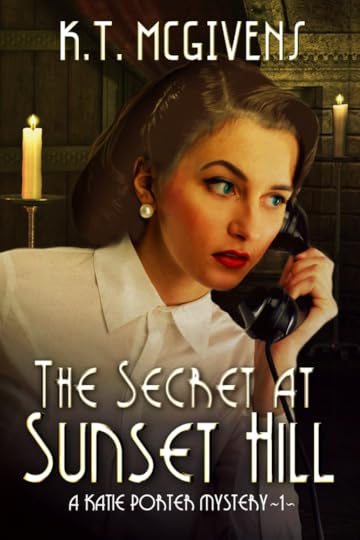
Katie Porter continues a long and much-loved tradition of young, intelligent women detectives like Nancy Drew and Trixie Belden. Why do characters like Katie continue to attract us?
I think it’s because we can identify with them so easily. They appear “real” because they don’t possess any magical or supernatural powers that help them. These are women we have either met in our lives, have as friends, or would like to aspire to be. They are smart, courageous, humble, and tenacious. And they use these traits to help other people. That’s very empowering!
The first book in the Nancy Drew Mysteries series was published in 1930 and the last in 2003. That’s a 73-year run! And new readers continue to discover them as the collections are passed down through the generations. So, there is obviously something there that resonates.
Unlike the younger Nancy Drew and Trixie Belden, who were meant for the pre-teen reader, I wanted a broader base of readership, so I made Katie Porter older and the mysteries more complex. This allows her to enjoy a wider array of experiences like a career, for instance, and a serious romantic relationship.
In 1947, at age 21, Katie Porter would have had more adult responsibility than her contemporaries today, but she is still young enough to be relatable to most readers. Surprisingly, although the books are appropriate for readers as young as 13, I have more people in their 40s and 50s, male and female, reading the series than in any other age group.
You have several reoccurring supporting characters in the books. Can you tell us a little about them?
I did make a conscious decision to include a reoccurring foundational “cast of characters” in the series that could provide me with different storylines for the mysteries.
However, it was also important to me to use them to dispel some of the innate prejudices and stereotypes we tend to place on people. For instance, I purposely wanted Katie to have two very close friends, one female and one male, so I created the character of E.M. Butler. He is lovable and loyal, and where Ruth White is often Katie’s conscience, E.M. brings out her sensitive playful side.
The very masculine Jim Fielding grows roses, is a gourmet cook, and wears his heart on his sleeve. The aloof, brash, tweed-wearing sportswriter, Midge Pennington, could be a lesbian, which Katie assumes with little thought or concern. But later in the series, we find that Midge is a widow who had been married to a man that she very much loved and is straight.
Which brings me back to E.M. Butler. He writes the social column for the newspaper and is an expert on fashion. The reader will not know for sure whether E.M. is gay, and the character will never say so because in 1947 such an admission could have gotten him killed. He is also the only man in the series that is a decorated war hero having received the Bronze Star for Valor.
The bottom line is that we are all human beings who should be treated equally with respect and kindness.
Your series takes place in 1947. Why did you pick that year?
The generation of that time period is known as “The Greatest Generation,” having lived through the great Depression and then World War II. I thought it would be great fun to place this smart, young, female mystery-solving journalist in their midst. I didn’t want to write about the war directly, but it did still have an impact on the daily lives of people for years afterward. Since it ended in 1945, two years later seemed just right. This helped give depth to my characters and influenced how they made decisions.
Those decisions are pondered by Katie at the end of each book when she writes in her journal. I want to give the reader something to think about. Often in life there are no right or wrong answers, as is the case in “The Secret at Sunset Hill.” I hope people will discuss these over the dinner table. Good versus evil, greed versus giving, kindness versus cruelty. Heavy stuff that is just beneath the surface of what I hope is a good mystery!
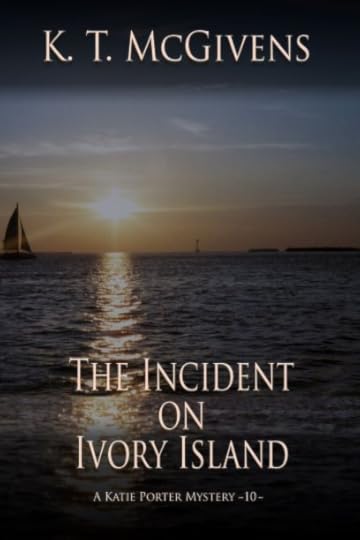
Do you plan to continue with the series?
Yes, absolutely! The adventures of Katie Porter and her pals have just begun!
Are there other authorial ideas springing to mind?
I am contemplating writing a novel that deals with growing older in today’s society. A serious topic that might be out of my ability to write, but we’ll see.
What is your publishing system?
I did a lot of research on this and made the decision to be an independent self-published author. And, for me, Amazon’s Kindle Direct Publishing (KDP) fits best. I say “self-published,” but I still need to meet KDP’s publishing standards, which can be somewhat overwhelming at times.
Please tell us a bit about yourself. How did you become an author?
I started out as a poet and in 1995 was traditionally published through a local publishing firm. I wrote six books of poetry which, unfortunately, are now all out of print. The firm went out of business, but not because of me!
My poems also appeared in local newspapers, community newsletters, and anthologies, and I am the recipient of two statewide first place poetry awards. Anyone interested can find my anthology of this work on Amazon titled “Dimming the House Lights.”
Then, just two years ago in 2019, I decided to take the risk of writing a mystery series, something I had pondered doing for years but didn’t have the courage to try. Finally, after formulating my characters and their literary universe in my mind for several months, I sat down and wrote the first Katie Porter Mystery, “The Secret at Sunset Hill.” I had no idea whether I would finish it, nor did I have any expectations on how it would turn out, but the darn book nearly wrote itself! I have found a new love!
In real life, I am a former public school teacher (physical education) and taught Grades One through Nine before transferring to health care. Although hoping to retire soon, I still work full-time and, for the last six years, have managed a nine-acre art district in the panhandle of Florida.
I have two grown children, a son and a daughter. I am a music lover and amateur musician and play five instruments. I love to be outdoors in nature and love all kinds of animals, especially dogs. My ex-spouse is disabled and lives with me, so I am also a caregiver.
If you have any spare time, how do you spend it?
Unfortunately, I don’t have much. But whenever I can, I write, write, and write! Usually in the evening after I come home from work and over the weekends.
Do you have any tips for aspiring authors?
Write because you love it! Not for money, fame, or to impress others. That most likely will never happen. Write because you feel compelled to do so! Write because it’s in your heart!
I recommend not setting word goals or expectations although that’s fine if that’s what motivates you. I find just getting the story out, no matter how long it takes, is what’s important.
Edit and proofread your manuscript before making it public and get the help of others. You may be able to do the editing yourself, but you will not be able to completely proofread your own words and catch every mistake. Our brains don’t work that way. Go over it a few times and then get someone else to read it. You’ll be amazed at all the typos and misspellings you didn’t see!
Build your team. This is harder than you think and will probably disappoint you at first. You’ll find that your family and friends might not be as supportive as you thought. It may take some time but establish a small team of trusted people to proofread, suggest edits, and design a dynamite book cover for you. It took me quite some time to find just the right people for my Katie Porter Mystery series, but it was well worth it! The same three people have helped me with every one of the books and I honestly couldn’t publish without them.
Don’t let anyone rob you of your author’s voice! People will be tempted to tell you how to tell your story. Pay no attention. If they want to read a story like that, tell them to write it! I had a friend cut one of my manuscripts to pieces because he wanted me to write like Jane Austen. If I could write like Jane Austen, I would be rich and famous. Only you know the story that you want to write. You probably go over it in your head. You probably create scenes in your dreams. This is your story. Tell it in your own way!
Finally, ask successful writers like J.C. Paulson for advice! She’ll share what makes her books so wonderful and will offer encouragement and support as well!
Aww, that is so kind of you! Thank you so much, KT!
You can find KT McGivens books at (URL): amazon.com/author/ktmcgivens
And on social media at the links below:
Blog: https://katieportermysteries.com/
Instagram: https://www.instagram.com/k.t.mcgivens/
YouTube Channel: https://www.youtube.com/channel/UCynN3LjXX4ofc0RoxZED_oA
March 13, 2021
Dawn Hosmer: Queen of the Psychological Thriller
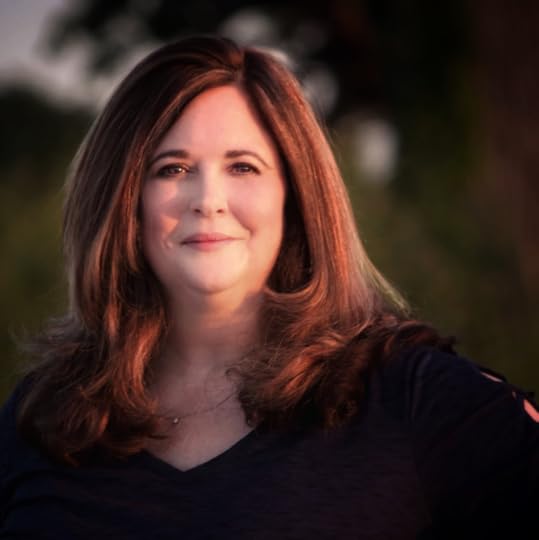
Dawn Hosmer weaves gut-wrenching stories from real-life inspirations and the constant authorial question: what if? Indeed, she is well-known in some quarters as the Queen of the Psychological Thriller. Meet the Ohio author, wife, mother and grandmother as she shares her story and publishing journey.
Please tell us a bit about your writing career. I believe you started with Bits & Pieces, a psychological thriller.
The first novel I wrote was actually The End of Echoes in 2008. I was inspired by a real-life event that shook me to my core. Writing it was cathartic for me and part of my healing process. I initially wrote it in third person past tense. After reading it through during re-writes, I knew it needed to change so I re-wrote the ENTIRE thing in first person present tense from five main characters’ points of view. It was so much work but exactly what the book needed.
After finishing the re-writes, I queried The End of Echoes, with the desire to be traditionally published. I queried solidly for two years and received over one hundred rejections. As hard as it was for me to accept that the book of my heart may not be the one to get me noticed, I wrote Bits & Pieces, thinking it may have more commercial appeal. I wrote it so quickly, which was refreshing. I then began querying both books.
Again, I received rejection after rejection after rejection. All of those rejections broke me. I know we’re supposed to say they don’t matter, and that each no is one step closer to a yes. But, in total transparency, they shattered my self-confidence. I was so broken that I could no longer write. But I kept querying, almost out of spite to see what would happen (or because I’m a masochist). Of course, I kept receiving more rejections.
In early 2018, a dear friend of mine convinced me to join Twitter because of the amazing writing community. I resisted because I really did not want another social media account to keep up with. Eventually, over the course of a dinner, she broke me down – thank you, Rachel Hopmoen – and I promised to join. As with most things, once I commit to something, I go all in. I decided to participate fully on Twitter and see what happened.
Within a few months of joining, there were several pitch contests. I decided to participate in both with Bits & Pieces. I got more agent and publisher interest in those two pitch contests than I had received in the previous ten years. I sent off my pages and synopsis to around twenty different agents and publishers. During #adpit, I had two publishing companies interested in my manuscript. One was a major publishing company in Canada. The other was a small, new independent publisher. Since my dream was to be traditionally published, I really wanted to go with the larger publishing house. However, the person who read my manuscript told me they’d love to work with me IF I removed the major plot twist in the book (if you’ve read it, you know what I’m talking about). The smaller publishing company was willing to take my manuscript as is.
I toiled and fretted over this decision for a week. I knew in my heart that the major twist in Bits & Pieces needed to remain. I was unwilling to make the changes to the book to be able to pursue a working relationship with the larger publisher. I decided to sign with the independent publisher. I know that this was the right decision for me because once I signed, I was finally (after several long years) able to write again.
Unfortunately, after about a year, there were some staffing changes that led me to ask for the rights back to Bits & Pieces which is now published by Gestalt Media.
Joining Twitter was one of the best decisions I’ve made regarding my writing. Not only did it help me find both of my publishers, it helped me find a community of amazing authors I now consider to be friends.
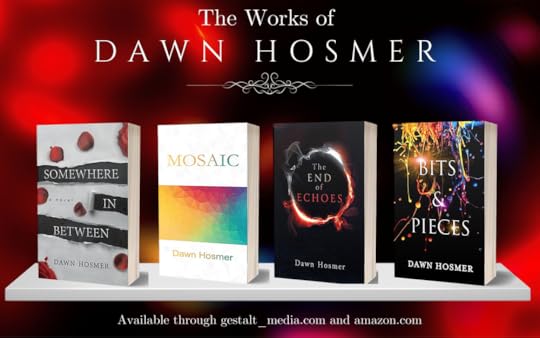
And now you have published four books. Are they all standalones?
My original intention was to only write standalone novels as this is what I prefer reading. However, readers really wanted more of Tessa’s story, so I’m now working on a sequel to Bits & Pieces. Writing a sequel is a real struggle for me and I really hope never to do it again.
Where do your inspirations and plots come from? And what are you writing now?
All of my books start with a question – What If? What if my child were abducted and murdered? (The starting point for The End of Echoes.) What if I had the special ability to pick up pieces of others through touch and happened to encounter the wrong person? (One of the starting points for Bits & Pieces.) What if I could witness my own funeral and had no idea how I died? (One of the starting points for Somewhere In Between.)
In addition, my books are always inspired by real-life events. I mentioned this earlier with The End of Echoes. Bits & Pieces combined my What If question with the tragedy of a young woman who went missing from my son’s college campus when he was a freshman. She was later found murdered and her killer was responsible for the rape and murder of several other women. Somewhere In Between also has some real-life events that served as inspiration. Mosaic is a collection of very short stories (or micro-fiction) which I pulled from some of the pieces I’ve written on Twitter in the daily hashtag prompt events.
I also spent my career in social work which has given me a treasure trove of inspiration. I’m inspired by many people I’ve met along the way who have found the strength and resilience to overcome the most seemingly insurmountable challenges. I quit working about four years ago because of my health. I was diagnosed in 2004 with Crohn’s disease and it has had such profound impacts on my life as most auto-immune diseases do. I hated to leave the work force as I’m passionate about helping others but my body demanded it. It’s been a blessing in disguise as I can now focus my time on writing as well as being a wife, mom, and now a grandma.
As mentioned previously, I’m currently writing the sequel to Bits & Pieces which should be released later this year.
Tell us a bit about your process. Do you write daily? Do you plot your books by chapter before starting to write, or just have a rough outline?
I’ve never been a daily writer and probably never will be, despite the promises I make to myself. The plus side to not writing daily is I rarely get hit by writer’s block as I write when my muse won’t stop shouting in my head which makes the words flow more easily.
All the craziness of 2020 really took its toll on me creatively and I couldn’t write more than a few thousand words once a month or so. I’ve recently started writing again, and it feels amazing. My muse is still playing hide and seek with me so what’s working for me to get the words down is this – I set the timer for twenty minutes, two times each day. I commit to putting words down on the page for that amount of time only. Using this method, I’ve managed to write 1,500 to 3,000 words per writing session for the past several weeks. I think it relieves the pressure enough to let the words flow without over-thinking everything (as I love to do).
I am a pantser through and through. As I mentioned earlier, I start with a question and sometimes an idea of who the main character is. I then sit down and write. I always keep a notebook nearby to write down main events, details about characters, questions that need answering, and sometimes plot points that need to be covered. Usually, the characters take over and tell me their stories as I write. I write the story in order, rather than jumping around and putting it all together at the end.
I’ve tried plotting ahead of time, but it kills my creativity and renders me unable to write at all. So, I’ve accepted my process as a pantser and honor it.
What do you like to read? Do you have a favourite author?
My reading is all over the place genre-wise, however my favorite genres are psychological thrillers, suspense, and mystery. My daughter and I recently started a mother/daughter book club podcast, Unravel The Binding, where we read and discuss books in depth with our listeners. We are focusing on psychological thrillers, suspense, crime, and mystery for now.
I have so many favorite authors. A few of them are Ruth Ware, Jodi Picoult, Liane Moriarty, Wally Lamb, Heather Gudenkauf, Mary Kubica, and Celeste Ng. (I seriously could write a whole page of my favorites)
Were or are you inspired by other authors?
I don’t know that I’m inspired by other authors per se. Rather, good story-telling motivates and inspires me, be it in book, movie, or TV show form.
Could you share some thoughts about publishing/writing in today's environment?
I think I held onto the idea for far too long that the only valid way to be published was traditionally. This may have been the case in 2008 when I started my writing journey, but it is no longer true. There are so many avenues to getting published now that weren’t available then. And all of them are valid with none being better than the other. In the future, I’d love to be a hybrid author – some books with an independent publisher, some self-published, and some with a traditional publisher. I find that the hardest thing about being with a smaller publisher or self-published is finding and connecting with readers. Marketing is an ever-changing beast. I recently joined TikTok to try to find new readers and engage with the writing community there. I think the key to successful marketing is being willing to try new things, even when they’re out of my comfort zone. I’ve often said that I don’t want my comfort zones to become my prison – I’m doing my best not to let that happen. Also, I’ve committed myself to saying yes to any writing-related endeavor that comes my way, regardless of how I feel about it. I’ve seen on my own journey that those things that present the greatest risk usually bring the greatest reward.
Thank you so much, Dawn.
Find Dawn Hosmer’s works on Amazon at this url:
https://www.amazon.com/Dawn-Hosmer/e/B07JGB6NS2
And at Gestalt Media:
https://www.gestalt-media.com/
And visit her website at:
January 30, 2021
The mysteriously prolific H.P. Bayne
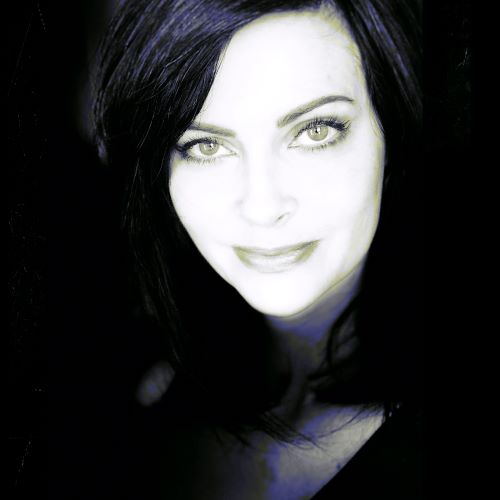
H.P. Bayne's first ghostly mystery, Black Candle, was unleashed in 2018. Since then, the by-day crime reporter has published six more novels in the Sullivan Gray series, plus a stack of standalone stories featuring the same characters. The books frequently appear in Amazon's top 100 in categories like ghost suspense and psychic suspense, and it's easy to see why. Her writing is clean, her plots taut, her characters real. Read on and discover the mysterious Bayne below.
Welcome, HP. You come by your fascination with mysteries honestly; I understand you are also a crime reporter. Can you tell us a bit about how factual writing turned into fiction?
Hi, JC, and thanks for the invite! I’ve been a crime reporter for two decades now, but I’ve been writing fiction far longer than that. Crime reporting has definitely helped big time when it’s come to my fiction. I don’t write about the cases I’ve covered, although they can inform my books in various ways. Most notably, I’ve spoken to numerous victims of crime and their families — particularly those impacted by homicide — so I’ve gained a perspective that’s enabled me, I think, to paint a picture not only of the crime itself but of those touched by it. I’ve also been lucky enough to get to know numerous members of law enforcement and the legal/judicial community who are always willing to answer questions for me related to my fiction. At the same time, I feel that novel writing has vastly improved my feature writing at my reporting job, so the two really complement each other.
This isn't just fiction, however. It's also about a tortured soul who sees ghosts. How did you develop the concept, and why ghosts?
I’ve always been a fan of gothic novels and shows. Since I was a kid, I’ve been fascinated by ghosts and read or watched shows about them whenever I could. That said, I never really considered seriously incorporating ghosts into my crime fiction until a few years ago when I came up for the idea of a mystery series featuring a guy who sees the ghosts of homicide victims. I had actually planned to finish up a trilogy in a more standard police procedural/thriller series, but I instead opted to write and release the series related to my ghost-seeing amateur detective. The time felt right for it, and I’m glad now I went that route.

Talk a bit about the two main characters, Sullivan Gray and his brother Dez. How do they work together?
The two main characters are Sullivan “Sully” Gray (the fellow who sees ghosts) and his foster brother, Dez Braddock. At the start, Dez is a police officer and Sully’s a bartender. As the series continues, Dez eventually loses his job, and he and Sully start working for a private investigator. By the time the spin-off series begins, they’re fully entrenched in that career.
As far as the characters themselves go, I’m a huge fan of “buddy cop/soldier/investigator” novels and shows, and I struggle to find series focused specifically on this type of relationship. The most recent (and highly successful) obvious example are the Winchester brothers on Supernatural — a show I really loved. Many of the other series I’m writing have a buddy element to them, and I thought it would be fun to write a pair of brothers, sort of like Sam and Dean, who are super-close but tend to peck at each other sometimes as well. Unlike the Winchesters, my guys focus solely on homicide cases with ghosts involved, but the brother dynamic is a commonality — one I’ve found my readers really love.
How many Sullivan Gray novels have you published? What's next for Sully and Dez?
I now have eleven books out — seven in the now-complete Sullivan Gray Series and four in the follow-up series called The Braddock & Gray Case Files. The initial series contains a standalone mystery in each book, but at its core, it’s about a young man coming to terms with what he can do, the light and dark parts of himself and the growing abilities he possesses. I actually had intended to simply end the series there, but I had enough interest expressed by readers that I started the follow-up series. These are purely standalone books, designed so I can continue to gauge interest and, if it wanes, I can wind it up without worrying I’m leaving the story hanging. I currently have the next book more than half written and more planned, as long as readers continue to be interested in the guys.
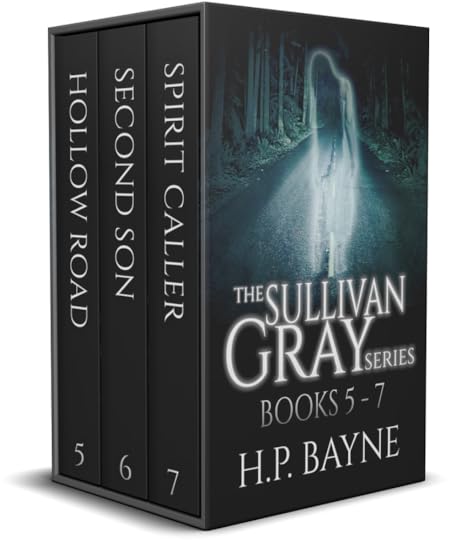
You're known for being very prolific, particularly considering the demands of your day job. Tell us about your writing process, and how you find time for it.
There are definitely people who write much more quickly than I do, but I am pretty quick thanks to a day job involving writing to deadline on a daily basis. Honesty, I wish I could write faster still, but I’m quite pleased to be churning out four books a year — particularly given how often my parents used to have to bug me to finish writing books when I was a teenager. I am quite terrible for coming up with ideas, getting started and then getting distracted by something else, so I’ve had to force myself to be more disciplined.
Given the demands of the day job, I had to figure out a time and a way to write that would allow me to hammer out between 1,000 and 2,500 words per day. I tried doing it in the evening, but I often found I was far too physically, emotionally and mentally drained at the end of the day to turn on my creative brain. Instead, I get up between four and six every morning (I don’t set my alarm anymore, I just allow my body to dictate when it’s ready to wake up) and write. I’ve actually discovered something about myself I never would have believed — I’m a morning person! The best part is that by the time I start my day job, I feel great, like I’ve accomplished something awesome already that day. During the pandemic, it’s really helped keep me sane besides.
Were you inspired by other writers? And what do you usually prefer to read?
I can’t honestly say this series is particularly inspired by anything I’ve read, although I loved the brother relationship in the Cal Leandros series, for example. As far as what I enjoy reading, I have been devouring Robert Crais’s books (a buddy PI series!) and I’m a massive fan of various British crime authors — my long-time fave being Ian Rankin. I’ve also got a bookshelf stocked with the classics. I love the Gothic elements of novels like Jane Eyre and Wuthering Heights, for example. In the next life, I’d love to sit down and have a chat with the Brontë sisters.
What's next in your fiction career? What are you working on?
I’m always working on something! I’ve always got a Sully book on the go, but I’ve got several other series I’ve been toying with — one for years, which features Regina, Sask.-based police detectives. I have rejigged and rethought the opening trilogy so many times, I sometimes think I’ll never get it done. As everything else I’m writing is non-paranormal, I am likely to publish those either under my own name or a pen name. I’ll continue to work on them until I have a few books ready in each, then gauge which is likely to be the best to market at that time. I like to have a small stable of books ready to go so I can quickly establish a regular release pattern that won’t be overly taxing for me going forward (particularly since as an indie, I do all my own advertising, marketing and promoting as well).
Other authors might be interested in your marketing approach. I know I am.
I maintain a mailing list, as well as a Facebook page and a group for particularly serious readers of the books. I try to respond to everyone who emails me, messages me or comments on my various posts or ads. As for advertising, I’ve tried a few things, but haven’t had much success with Amazon ads to date. My biggest focus is on Facebook ads. It was a process trying to find the right combination of images, copy and targeting, and I actually ended up eventually taking a cover design course (thanks, Stuart Bache/SPF!) and redesigning my covers from scratch. That really helped my ads take off, I think, and my sales increased quite soon after. (I incorporate images from my book covers into the ads.)
I also managed to secure a coveted BookBub feature deal (international, not US) last summer on my first box set, which gave me another brilliant boost. And Amazon has run a number of monthly features on my first-in-series, which has also given the other books a nudge. As well, I’ve used a variety of promo sites and have had success in particular with Freebooksy and ENT. I only ever advertise/promote my first-in-series, my first box set, the first Amazon series page or my Amazon author page, counting on read-through to look after itself — which it does.
I didn’t start properly marketing and advertising until I had three (or was it four?) books out as I wanted to capitalize on read-through, and I’m glad I did it that way. For me, more money has come with simply having more books, and making sure the books are what my readers want. I’ve got a stellar ARC team and a brilliant editor who are great for keeping me on track.
Where can we find your work?
All of my books are enrolled in Kindle Unlimited so are Amazon exclusive. They’re available at Amazon stores worldwide. I’ll post universal links to the series pages below. Thanks again for the chance to be a part of your awesome blog, JC! I’m in great company here (plus I love your books — especially since they’re set in my home province). All my best to you as always. I hope you know what an amazing support you are for other authors.
Awww, Bayne. Thank you so much. Check out HP Bayne’s incredible series at the links below.
Website: hpbayne.com
The Sullivan Gray Series:
The Braddock & Gray Case Files:
,mybook.to/BraddockGrayCaseFiles

January 2, 2021
Sneaky Peeky of Two Hundred Bones

1962, Northwestern Saskatchewan
The aging Chevy careened down the narrow trail, spraying gravel and sliding dangerously near the precipitous road’s edge.
The night held neither moon nor star; a thick blanket of threatening cloud obscured the sky. Only the car’s dimming headlights illuminated the towering forest looming ahead.
“One more run, that’s all we asked for,” grumbled the driver. “Not too late to change your mind.”
He gunned the engine. The man in the back seat sucked in a breath as the wheels slipped perilously sideways, just as they crossed a bridge over the tumbling river. Bridges in these parts had no railings. The infrastructure wasn’t crumbling. It simply didn’t exist.
“No,” the man said, straightening his spine. “I’m out.”
“Maybe we can convince you,” said the passenger. His mouth contorted into a sneer as he opened the glove box, drew out a pistol and aimed it over the seat.
“Now, no call for that,” said the man, drawing his body backward. “For Christ’s sake, it was one lousy run.”
“The biggest one. You were the only one they trusted. Now what’re we gonna do? Hey? What?”
The driver took a sharp right, barely navigating the turn onto an even narrower trail. The big car took up the entire width of the slick dirt road; fir tree branches slapped and scratched the sides.
“What the hell?” asked the passenger, his fingernails embedded in the dashboard.
“We have company,” the driver answered curtly.
The man in the back twisted his neck around with a spurt of hope. Seconds later, he saw the lights of the pursuing vehicle; but they flashed past on the main trail. Oh God, he thought.
Suddenly the Chevy was airborne, flying over a hill unseen in the utter darkness. The failing headlights shone directly ahead, giving no warning of uneven terrain. The car bottomed out with a bone-rattling thunk as the undercarriage made a hideous crunching noise.
“Shit,” swore the driver, and wrestled the steering wheel hard right for the second time. The dying vehicle rolled several metres into the dense trees, wheezed, and stopped.
The man in the back lunged for the door handle, wrenched it down and lurched out of the car, but not before the passenger spun and pulled the trigger. A bullet grazed the man’s arm and sprayed into the thin metal of the door.
Bent at the waist and wounded, the man ran deeper into the forest as quickly as his posture would allow, trying not to pant with exertion and pain.
“Get the fuck back here!” screamed the driver.
The car was dead, but the battery was not. Not quite. The faint remaining glow of the lights revealed the running man, glinting off the side of his glasses. He stumbled in the thick foliage, roots reaching out to baffle his footing.
A volley of bullets broke the dead quiet of a northern night.
The killers had brought their shovels. They rolled the man’s body down a short incline and covered him in earth before stumbling back toward the trail. A lake awaited, as they knew it would, down a series of small hills. They almost tripped over a rotting fishing boat, climbed in, and paddled away.

